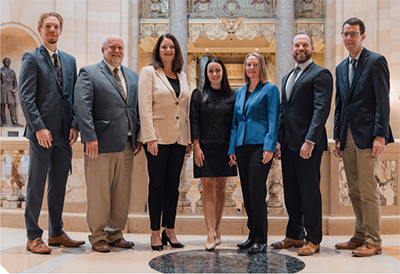What to Watch for During the 2024 Legislative Session
By Deborah Lynn Blumberg
In a momentous legislative session, Minnesota lawmakers ushered in the adoption of 74 new chapters of law in 2023 that included significant tax cuts, paid family and medical leave, and the legalization of adult-use cannabis.
The Democratic-Farmer-Labor (DFL) Party-controlled session, which started with a $17.5 billion general fund surplus, saw the introduction of a record 6,705 bills, and passage of a $2.6 billion capital investment package or bonding bill. Gov. Tim Walz vetoed one bill during the busy session, his first veto since he took office. Walz blocked a bill that would have set a minimum wage for Uber and Lyft drivers.
“We’re coming off a very consequential legislative session,” said League of Minnesota Cities Intergovernmental Relations (IGR) Director Anne Finn. “Legislators identified priorities early and moved aggressively with getting bills drafted and heard. They accomplished what they said they were going to do. The second year is always different from the first.”
While the first year of the Minnesota Legislature’s biennium is considered a “budget year” focused on passing the state budget, the second is typically a “bonding year” focused on capital investment projects as well as general budget tweaks. With expectations for another — though smaller — surplus for the mid-February to late May session, there may be ample room for changes, Finn said. “There very well could be another capital investment bill, especially since we’re going into an election year,” she said.
In this bonding year environment, city officials should start conversations with their legislators, she adds, so legislators are aware of local priorities. One effort that surplus money could support is Emergency Medical Services (EMS) sustainability across the state, said Finn.

Recognizing EMS providers in recent years have faced persistent funding and staffing challenges, the League convened a task force to look at the issue. “EMS funding is a logical way to spend,” said Finn.
Legislators could also earmark part of the state budget to tide cities over as they wait for ongoing funding for city streets that won’t begin until 2026.
In this Q&A, League IGR staff — including Nathan Jesson, Daniel Lightfoot, and Alex Hassel — discuss some of the major legislation passed in 2023, how new laws may impact cities, and what cities need to keep in mind as 2024 gets underway.
Q What happened in 2023 with local sales tax proposals?
Nathan Jesson: Along with approving the local sales tax proposals within the omnibus tax bill during the 2023 session, the Legislature put a moratorium on local sales tax proposals for the next two years. This was done partly because the number of local sales tax requests significantly increased in recent years. The practical effect of this moratorium is that the Legislature will not consider any local sales tax proposals during the 2024 or 2025 legislative sessions. The moratorium doesn’t apply to local sales tax authorizations or modifications included in the 2023 omnibus tax bill.
Q How will the moratorium on local sales tax proposals impact cities?
Nathan Jesson: It means that cities (and other political subdivisions) cannot engage in activities connected to imposing a new local sales and use tax or modifying existing ones. So, this includes activities like advertising or using funds to promote a referendum to support imposing a local sales tax, carrying out a referendum, adopting a resolution supporting a local sales tax, and even holding public forums or providing facts and data on any local sales tax and the impact it would have or the impact of projects that it would fund. Cities also can’t seek voter approval for a local sales tax.
Q At the same time, the Legislature established a Local Taxes Advisory Task Force. What will it accomplish?
Nathan Jesson: As part of these efforts to examine the local sales tax process, the House and Senate tax committee chairs created a seven-member Local Taxes Advisory Task Force. The idea was to bring experts together to see if there could be a better way to address capital projects and other improvement projects moving forward. The group started meeting in August 2023 and is looking at how cities and counties use local taxes to fund capital projects. The task force has been asked to come up with objective evaluation criteria for local tax proposals — including what types of projects should be eligible — and a better process for authorizing them.
One issue in the spotlight is whether projects must benefit an entire region in order to qualify and what defines “regional,” since the definition varies drastically in different parts of the state. The task force is slated to issue a report to the Legislature in early February 2024 with recommendations for possible changes. The League has been actively involved with the task force, with LMC President Jenny Max, city administrator for Nisswa, representing cities.
Q What should cities have top of mind when it comes to local sales tax proposals?
Nathan Jesson: Cities that had local sales tax proposals approved in 2019 or 2021 may face issues due to inflation increasing the costs of their approved projects. They might run up against hitting the total revenue raised limit much sooner than they originally anticipated. With the local sales tax moratorium in place in 2024 and 2025, it will likely be years before those types of projects will be considered for modification.
Q The 2023 tax bill included $210 million in one-time public safety aid. What are eligible uses of the aid?
Nathan Jesson: Unlike local government aid, this money can’t be used for general purposes. Instead, cities have to use it to “provide public safety.” Language in the law provides categories of eligible spending, but the list isn’t exhaustive. Also key is that, while legislators expected that cities would put most of the funds toward police and fire, they intentionally wrote the bill broadly to allow for other uses. Some allowable uses named in the new law include community violence prevention, intervention programs and engagement, mental health crisis responses, victim services, and equipment related to fire, rescue, and emergency services. The broadest category is “other personnel or equipment costs,” and much of the aid may end up there.
Q What about ineligible uses of the public safety aid?
Nathan Jesson: The law also calls out a bunch of ineligible uses, such as the purchase of an armored vehicle or tear gas and construction costs around expanding or remodeling a police station. Cities will have to consult with their attorneys and use their best judgment to determine whether a use that is not clearly defined as eligible or ineligible is allowed. And, like with any state funds, use must be closely tracked and documented in order to respond to any future inquiries or program evaluations.
Q The 2023 legislative session’s $1.065 billion housing omnibus bill was the largest single investment in housing in state history. What do cities need to know about this?
Daniel Lightfoot: Funds will support the construction, acquisition, and preservation of housing. The bill also includes nearly $300 million in direct appropriations to cities, and new and existing grant opportunities for cities to support local housing efforts. What’s key is that, for the first time in state history, the Legislature created two new programs that will provide direct formula-based funding to cities above 10,000 in population to support building and maintaining affordable housing. It also made available discretionary funds for Greater Minnesota cities below 10,000 in population for similar purposes. We saw other new programs, too, including $8 million in state grant funding to help cities cover the cost of infrastructure needed to attract and support residential development. Inadequate infrastructure is often the single largest barrier to housing production in the state.
Q What can we expect during the 2024 legislative session for cities and housing?
Daniel Lightfoot: The state’s historic budget surplus in 2023 made possible unprecedented levels of funding for housing construction and preservation across the housing spectrum. In 2024 the Legislature is likely poised to set its sights on policy, especially with a more limited supplemental budget. One priority will likely be around landlord-tenant issues. Specifically, efforts to address the problem of landlords who refuse to rent to a housing applicant who’s receiving housing assistance.
In response to Minnesota’s substantial housing supply and affordability gap, legislators on both sides of the aisle are likely to follow a recent trend we’re seeing in states like Washington, Colorado, and Montana. These states are focusing more on state intervention on local land use and zoning policy. In Minnesota, this could come in the form of requiring zoning for higher density areas and prohibiting architectural design standards. The League will work closely with legislators to advocate for a continuation of the state-local partnership around housing, and will support efforts that continue to allow zoning and land use changes to be locally led and community-driven rather than a one-size-fits-all approach from the state.
Q What are some important takeaways from the 2023 legislative session on employment laws?
Alex Hassel: The most pressing change to employment law this past legislative session was the enactment of an earned sick and safe time requirement that all employers must administer. The new law means employers have to provide their employees with one hour of paid sick and safe time for every 30 hours worked for up to 48 hours the first year and 80 hours for ongoing years. This law applies to all employees, including part-time and seasonal workers. The law went into effect Jan. 1, 2024, and requires all cities to provide a certain standard of short-term leave benefits. It has no impact on existing paid leave policies that meet or exceed the new requirements.
Q What do cities need to do in light of this new law and other employment law changes?
Alex Hassel: If they haven’t already, cities will need to evaluate their existing leave programs to make sure they’re in compliance with the new law. If a city doesn’t have a leave program, it will need to implement one that meets the state’s minimum standards. The new law doesn’t prevent a city from providing more generous leave benefits. Cities also need to have a few other new employment-related laws on their radar. Changes to the Minnesota Public Employment Labor Relations Act will impact bargaining negotiations. A new paid family and medical leave law creates a statewide insurance program for longer-term paid leave that employers will be required to participate in. That program starts in 2026. All of these changes to employment law will drastically impact how cities and other employers navigate benefits for their employees for years to come. Learn more about recent employment law changes at lmc.org/employmentlaw23.
Deborah Lynn Blumberg is a freelance writer.

